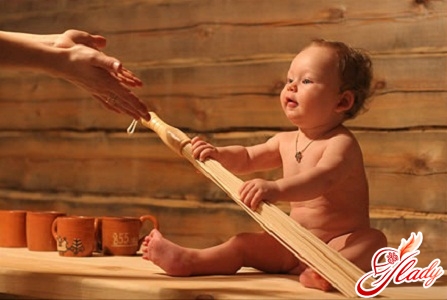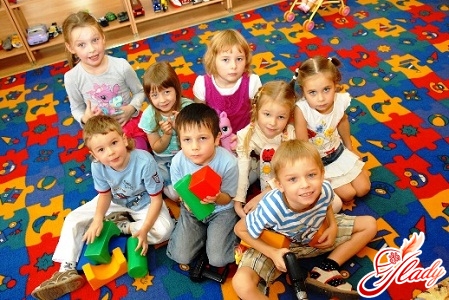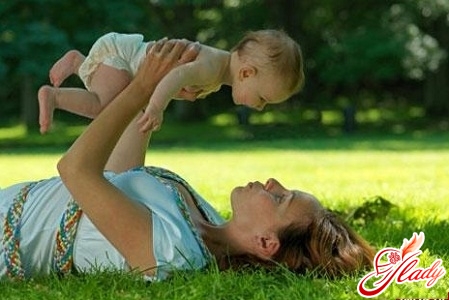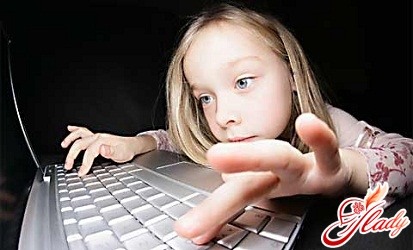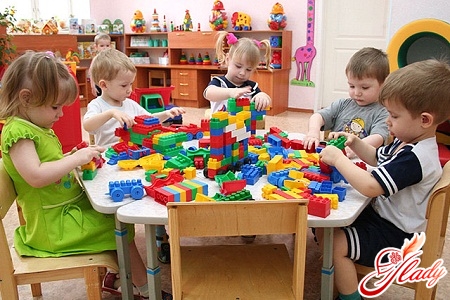 "How is my son or daughter?" Do not hurt a child in kindergarten? And what if the child cries in the kindergarten, calling mom? ". Such thoughts, despite the terrible employment, come to the head of all parents without exception, at least periodically during the working day. And these fears are completely normal and natural, because everyone wants only the best for their child. And giving their crumbs to the care of even the best teachers, parents lose the most important thing for them - the ability to control the child's life, even if only at a time when the baby is in kindergarten. Most often, these anxieties arise precisely from ignorance of what the child is doing when he is in the kindergarten. Of course, it goes without saying that in general terms the daily routine in the kindergarten is known to any father and mother. However, not everyone knows what happens to their child at every stage. This is exactly what will be discussed in today's article.
"How is my son or daughter?" Do not hurt a child in kindergarten? And what if the child cries in the kindergarten, calling mom? ". Such thoughts, despite the terrible employment, come to the head of all parents without exception, at least periodically during the working day. And these fears are completely normal and natural, because everyone wants only the best for their child. And giving their crumbs to the care of even the best teachers, parents lose the most important thing for them - the ability to control the child's life, even if only at a time when the baby is in kindergarten. Most often, these anxieties arise precisely from ignorance of what the child is doing when he is in the kindergarten. Of course, it goes without saying that in general terms the daily routine in the kindergarten is known to any father and mother. However, not everyone knows what happens to their child at every stage. This is exactly what will be discussed in today's article.
"Early in the morning, at dawn"
We hear the unobtrusive sound of the alarm clock and reluctantlyopen your eyes. And educators at this time are already on their way to work. No late buses, broken cars, storms, tornadoes, tornadoes, ice and other unimaginable natural disasters can not cause the tutor to be late for work. The doors of the group should be flung open to meet their babies at exactly 7.00. The main stream of arrival of children begins at 7.30 and lasts until about 8 am. As a rule, not every morning the kids get up vigorously and in a good mood. Some of them did not get enough sleep and so they are capricious, someone does not want to part with their mother. Therefore, often in the morning in groups of kindergartens, especially younger ones, there is a deafening roar in the mornings, as often a child goes to kindergarten reluctantly. And the task of the educator is not so simple - to calm the roaring heels - the other kids. As a rule, it takes not so much time. Having lost their most important spectator - mom or dad, children very quickly stop roaring. And by the time the pope leaves the kindergarten and takes out a cigarette lighter with trembling hands, or his mother quietly smacks a tear, the little one already thinks that he has just been roaring.
"One, two, three on charge become!"
Also every morning the tutor spends with the kidscharging. Charge is an urgent necessity for the child's body. For kiddies of older groups, charging is necessary to maintain vitality, and the youngest crumbs charge is an excellent way to learn how to coordinate their movements. However, as you understand, charging for schoolchildren and charging for kids are two completely different things. Such a banal phrase as "put your feet on the shoulder width" children do not understand, and therefore just ignore. Morning exercise for babies is more like a real theatrical performance, where the role of the director is assigned to the educator. To explain to the child what exactly is required of him at a particular moment, it is possible only with the help of the associative series - the hare jumps, the ducks walk, the turtles crawl. As a rule, morning exercises are performed under musical accompaniment, which is very pleasant for children and turns exercise into an exciting action. By the way, very often the adaptation of the child in the kindergarten is more smooth due to the morning exercises.
Breakfast in the kindergarten
During breakfast, discomfort andconflicts. Very often children have breakfast at home and come to the kindergarten already full. Of course, in such a case the child will not want to have breakfast, and the teacher will insist that the baby eat. In order to avoid such misunderstandings, if your child prefers to have breakfast at home, you must first discuss this issue with caregivers. Equally often the opposite situation occurs - the child for some reason is late for breakfast and remains hungry. Of course, this is not the case in all kindergartens, but only in those in which a certain number of portions are given in the kitchen, in accordance with the number of children available. But in any case, knowing that you and your baby are late for breakfast in kindergarten, first call the tutor and warn him about it so that your child is left breakfast and he did not remain hungry until lunchtime. Teachers' phones should be for all parents without exception. The very nutrition of children in kindergarten also requires increased attention and responsible approach. Until recently, all the worries related to the process of feeding were entirely on the shoulders of the caregiver's assistants, or, to put it simply, the nannies. However, in recent years, not only the caregiver's assistant, but also the educator himself, is concerned with the nutrition of children. Nyanechka brings food to the group, and the tutor distributes it among the kids. They both watch how the children eat, and if necessary, help the kids. After breakfast, the teacher takes care of the children, and the caretaker's assistant is cleaned after breakfast. 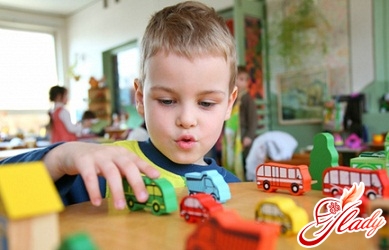
"Learning is light"
As is known, the tasks of the kindergarten are notonly supervision of children and their feeding, but also classes with children, whose goal is the comprehensive development of both the physical and mental abilities of children. Of course, most of the lessons with children are conducted by specialists - defectologists, psychologists and speech therapists. However, the educator also invests a considerable amount of work and soul in the development of our children, in spite of the fact that we parents are used to it. That the duty of the caregiver is only a mechanical process of caring for the child: dress, take out for a walk, undress, feed, put to bed. What exactly our children will be engaged in classes depends on their age and skills. Most of the classes in one way or another are deliberately linked by teachers with certain natural phenomena. Many parents are surprised by this fact and sometimes even openly indignant, they say, why all the conversations and classes in the kindergarten are reduced to banal nature studies. However, do not forget that children of the Garden Age are still very small and because of their age they can not perceive complex information that is not backed up by any examples. And the world around us is the best way to understand this or that phenomenon. After all, examples can not be more obvious. In developing classes, children are engaged in drawing, modeling, appliqué. And these classes are held for a reason. So, for example, drawing not only develops creative abilities in a baby, but also teaches him to distinguish and remember the names of colors, while drawing, the child learns to hold pencils and brushes correctly. Molding from plasticine also has a very positive effect on the development of the child, especially small motor skills. And after all, as it is known, it depends on fine motor skills how well the child pronounces certain sounds, how his speech as a whole is developed. Or, for example, applique. It would seem that ordinary paper, but what room it leaves for the child's imagination! For example, three regular circles of various sizes, from which you need to fold and paste on the cardboard of the snowman. Before the eyes of the child should be a sample, and the task itself is most appropriate to give in the winter. As a result, the simplest appliqué acquires almost a global meaning, especially for the younger ones. After all, it turns out, you can make balls out of snow, and from balls, in turn, real snowmen, the same as children seen in cartoons. Thus, the child develops both imaginative and logical thinking.
One, two, three, four, five - go bunnies to walk
As a rule, after the end of the developmental activities,In the event that the weather conditions allow, the teachers dress children and take them out for a walk. The length of the walk depends on how many developing activities are in children. Most often the younger groups go for a walk at 10 am, and the older ones at 10.30. In most kindergartens, walks end at around 12.00. Despite the fact that there are established sanitary norms concerning the walks of children in kindergarten, all the decisions on the expediency of children staying in the open air are taken by the educators on the spot. So, for example, if in the street the air temperature is above the lowest possible +10 degrees, but the rain is pouring, and the wind is tearing from the umbrellas, no one will take the kids for a walk. After all, the main goal of walks is the rehabilitation of the child's organism, and walks in bad weather can not bring any benefit. Tempering children in kindergarten is not about walking in the rain. But in the summer, on the contrary, even some classes the teachers are ready to hold it for the street, so that the children can spend an extra hour on the street. But you can also draw on asphalt, right?
Dressing for a walk
Kohl already talked about walks, you can notto tell about such an important and difficult matter as the process of dressing a child before a walk. In the summer of this problem, in principle, does not exist - it is enough just to re-brush the kids. But in the winter, this process turns into a whole art. Especially in the case if the kiddies are going to children of younger age. So, for example, if in older groups children dress almost completely independently, and teachers only occasionally help to cope with disobedient buttons or lightning. But in younger groups, educators have to dress kids, which says "from and to." As a rule, at the beginning of the dressing phase all the kids take off shorts, panties, dresses or sarafans, in which the crumbs go to the group. After that, the babies, with the help of a nanny and a teacher, wear warm blouses, sweaters and panties, which can not be dispensed with during the cold season. After that, the crumbs are put on extra warm socks and boots, as well as jackets and overalls. After that, they put on hats on the crumbs, and gloves and, finally, the last solemn moment-the scarf tied around the neck and the teacher makes sure that the loins of the crumbs, his ears and neck are safely hidden from the frost. Of course, in order to quickly dress all children and not allow them to sweat, in the process, not only the teacher, but also the nurse is actively involved. And the teacher herself, as a rule, dresses as she runs along the corridors. On a walk next to the children is only one adult person - a teacher. And the caretaker's assistant at this time tidies up the room where the babies are - conducts wet cleaning, airs the room, removes the toys in places, so that all the children will be in perfect order for the arrival of the kids. Such measures allow creating sanitary conditions favorable for children's health. After the walk, the teacher and her assistant help the children to undress. While the children, under the care of the teacher, wash their hands and sit down at their places for the tables, the tutor's assistant brings food to the group. Approximately from 12.00 to 13.00 in the kindergarten lunch time. Meals for lunch last much longer than during breakfast. The menu includes the first dish, and the second, and the third. During dinner there is also everything - some kids adore soup, others, on the contrary, can not tolerate it, someone adores cutlets, and someone - mashed potatoes. Some children themselves eat everything they are offered, and others refuse to take a spoon in their hands and they have to feed the teacher and nurse. Some crumbs completely reject certain kinds of products, for example, salads from beets or cabbage. As a rule, the teacher does not make the crumb eat those foods that he categorically rejects, because it violates the rights of the child in the kindergarten. However, it is much more reasonable on the part of parents to warn the provider in advance of those products that the child categorically does not accept or are contraindicated to him for health reasons. However, there are a huge number of gifted educators who even turn out the hated salad as the most favorite dish. After all, as you know, the best way to persuade a child to do anything is play. It is in the game form that it is best to feed a small nehochuhu. 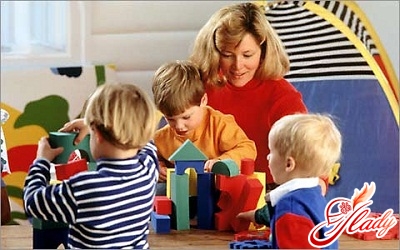
"Who was sleeping on my bed?"
After lunch, it's time for lunch,because the child's body needs a full rest. So, the dinner is over, the pens are washed and it's time to go to bed. In older groups, children undress themselves and put their clothes on a highchair. But in the younger groups with this question, everything is a bit more complicated - the kids do not know how to undress themselves, and even more so to fold their clothes. In order to teach the child the skills of self-service, it is necessary to try everything - and the tutor, and the nurse, and the very crumb. After everyone has settled down, the teacher will cover the children with blankets, and will begin to lull the crumbs. Some teachers read or tell a fairy tale, others sing a lullaby song. As a rule, very soon the tired children fall asleep with a sound and healthy sleep. However, of course, there are those crumbs that do not want to sleep during a quiet hour, especially in older groups. Such children are extremely reluctant to go to bed, long spinning, are distracted by conversations with educators, preventing them from sleeping other children. Typically, these babies eventually fall asleep, but a little later than all the other kids. As a result, by the time you need to wake up, the crumb does not have time to get enough sleep and, as a result, is capricious. In such cases, parents themselves are often to blame, which at the weekend absolutely do not adhere to the daily routine of the child. As a result, the weekend was over, the child went to the kindergarten, and his schedule is constantly confused, and he has difficulties with falling asleep in the kindergarten.
Sleep tired kids
While the babies are quiet - they are sleeping peacefully, at the tutorit's quite "hot" time - work with papers and documents. After all, it is necessary to inform the manager of the kindergarten about what exactly the educator deals with the kids, and necessarily in writing. Each charge, each lesson should be described in all details - in fact the work of the teacher can be checked at any time by the methodologist. Yes, and the question of how improving children in kindergarten is strictly controlled by doctors who also want to receive a report.
After waking up
A child's dream lasts until three in the afternoon. By this time, some children wake up on their own, others have to wake up the teacher. Children need to help get dressed, and girls need to be combed too, so they look neat. After the children are put in order, they will have an afternoon snack. As a rule, a delicious and healthy product is offered to children for a snack. For example, an apple, an orange or a cookie with milk. After the children have eaten, they with new strengths are taken to break the order in the toys that was induced during the quiet hour. As a rule, at the beginning of each academic year, parents are told about the mugs in the kindergarten. And after lunch, the children are engaged in the sections that their parents have chosen for them. The same children, who do not do anything extra, continue to play in groups, under the strict supervision of educators, because the safety of children in kindergarten is a priority. After 17.00 there comes time for dinner, after which, with the condition that the weather conditions allow, the whole baby goes for a walk. It was at this time, approximately from 17.30 to 18.30, the parents begin to take their crumbs home. The next weekday garden day is over. And do not forget to talk with your baby - after all, a kindergarten through the eyes of a child can look quite different. We advise you to read:





